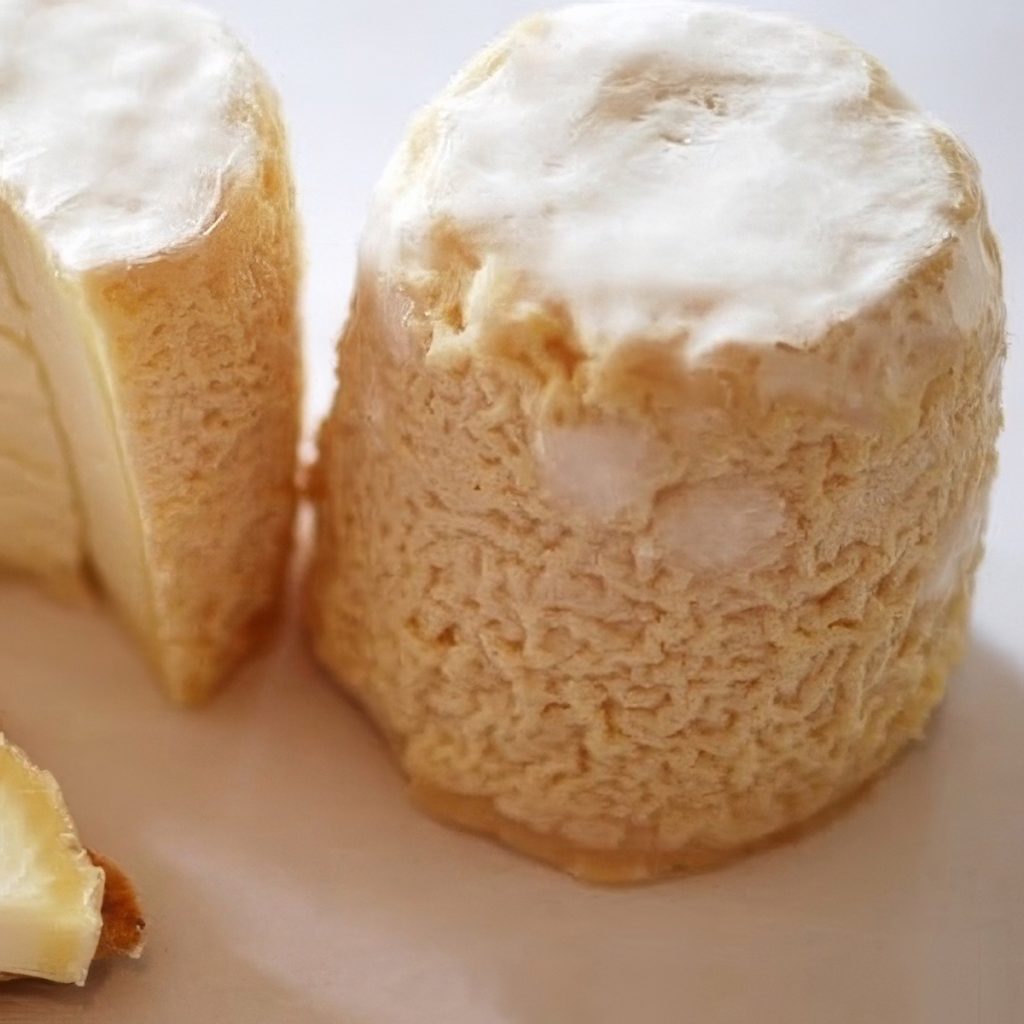Chabichou du Poitou Cheese
My wife sent me to the Ardmore Farmer’s Market with instructions to come home with a “delicious, creamy goat cheese that can be spread on crusty French bread.”
With a mission in hand, I immediately checked in with my favorite cheesemonger, Jack, who turned me onto Chabichou du Poitou, a soft, unpasteurized goat’s milk cheese made in the Poitou-Charentes region of France.
This delightful cheese may be available if you have a great cheese shop near you, but if not, I’ve listed a couple of online sources at the end of the post.
The Short Story
- Type: Goat’s milk
- Origin: Poitou-Charentes region, France
- Process: Barely ripened (10 days to three weeks)
- Texture: Firm and creamy
- Shape: Cylindrical to slightly conical
- Color: Bright white
- Rind: Thin and white with some yellow and blue mold
- Flavor: Sweet, goaty, salty, slightly acidic
The Rest of the Story
Like many other famous cheeses, Chabichou du Poitou is only produced in specific regions. This cheese is made in the Poitou-Charentes region.
For those of you who, like me, aren’t very familiar with French geography, the Poitou-Charentes region is about 100 miles north of Bordeaux and about 30 miles inland from the west coast. It is halfway between Paris and Bordeaux.
About the size of a wine tumbler, it is made from whole goat’s milk and has the characteristic “bright white” color in its interior. What makes this cheese so special is that it not only has an edible rind but also a thin buttery layer right beneath the rind before you slice it down into the firm, creamy, white center.
These three flavors and textures give this cheese such complexity. It is very “goaty,” but in the best way possible. It also tastes somewhat sweet, with a salty/tangy edge at the end when you swallow.
You can eat Chabichou du Poitou when it is young (up to 3 weeks) with a white paste that may be a little chewy, ripe (up to 6 weeks) with a spreadable texture and sweet flavor or dry (2 months) with a nutty flavor. Each will offer you a slightly different taste.
The Chabichou I tasted was perfectly ripe, spreadable, mild, and melted in your mouth.
A Little History
I was surprised to find out that the Romans introduced the first goats to France. Much later, the Saracens raised goats around the Loire Valley until they were eventually pushed out during the Battle of Poitiers. When they left, they left behind their goats and the recipes they used to make goat cheese.
So, the Chabichou du Poitou, named for the Arabic word for “goat,” has a history that begins back in the 8th century!
How It Is Made
While there is some industrialized production of Chabichou du Poitou, the best are still made using traditional methods. The process starts with whole, unpasteurized goat’s milk. It is slightly pressurized for a brief period, and then the curd is left to set up for a day or two at a specific temperature.
Afterwards, the curd is packed into perforated molds. The perforations allow the whey to drain and the curd to become more solid. After draining and turning, they are turned out of their molds and packed either in brine or with crystalline salt.
Then, it is further drained, dried, and then aged for at least ten days or up to three weeks. Some cheeses are even aged up to three months for a much more pronounced flavor and firmer end product.
Food & Wine Pairings
Like many goat cheeses, Chabichou pairs nicely with white wines. It is particularly nice to have with a chilled Sauvignon Blanc. If you can find a wine from the Loire region in France, that would be ideal. I like to enjoy Chabichou du Poitou just spread on a crusty baguette, but you could even serve it as a light end to a springtime meal.
I would not, however, sprinkle it on a salad. It is much too wonderful and complex on its own. A “lesser” goat cheese would work just as well, and perhaps even better, because it would be milder and would pair better with a vinaigrette. For the same reasons, I would never melt it into a sauce.
I did find one classic preparation that reminds me a little of a Caprese salad: put alternating slices of Chabichou du Poitou, cornichon (pickle) and tomato on a bed of cooked rice in a small baking dish. Sprinkle with a little oregano, thyme, salt and pepper and then drizzle with olive oil. Bake at 350° F for half an hour and serve warm.

Online Source: Cheese
I would encourage you to find a good cheese shop near you so you can get to know your cheesemongers, and they will get to know you. However, if you don’t have a good local cheese shop or they don’t have some of the cheeses, I recommend checking out Di Bruno Bros. online. Di Bruno Brothers is close to home to me. They have been in Philadelphia since 1939 and prided themselves on bringing fantastic food to the city of Philadelphia and drawing food lovers together in their ‘home.’ They also have a store outside Philly where I get most of my cheese and cured meats. If you can’t find a particular cheese in your market, most likely, Di Bruno Bros. will.









One Response
Had this cheese in Tahiti, and thought it was wonderful. Saved the wrapper and having a hard time finding it in Scottsdale, AZ. But, I spoke to someone at Whole Foods who said that he would try and order it for me. We shall see.
Hi Sheila, Scottsdale is a big city. They must have a gourmet cheese market you can try. I can’t believe they were serving this in Tahiti. Thanks for sharing and good luck finding the cheese. – RG